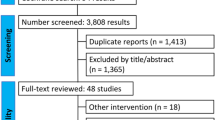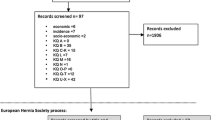Abstract
Purpose
Parastomal hernia remains a significant source of post-operative morbidity. Existing surgical solutions have shown limited success while not addressing the biomechanics underpinning parastomal herniation. The primary objective was to examine the influence of stoma aperture shape on abdominal wall stress and tissue destruction. The secondary objective compared mesh designs with respect to abdominal wall stress.
Methods
Finite element analysis of an abdominal wall model was used to simulate various stoma and mesh designs. The outcome measures were abdominal wall (mmHg) pressure required to initiate tissue tearing, stress distribution and median and peak abdominal wall stress (N/m2).
Results
The simulation demonstrated that the cruciate stoma incision developed high stress concentration at the apices of the slit incisions. The circular stoma incision distributed stress uniformly. The circular stoma design was more resistant to tissue tearing. The Keyhole mesh design demonstrated the lowest median and peak stress at 17.32 and 28.01 N/m2. This was a statically significant reduction in stress compared to the Sugar Baker and no mesh designs (p < 0.001).There were no significant differences between the Keyhole mesh design and loose mesh designs as long as the loose mesh design aperture did not exceed 1.5 times the stoma aperture diameter (p = 0.223).
Conclusions
This study has demonstrated that the shape of the fascia incision and mesh design have a significant impact on parastomal hernia formation. Novel designs can be used to optimise the stoma. The circular stoma and loose mesh designs are promising avenues for future research.






Similar content being viewed by others
References
van Dijk SM, Timmermans L, Deerenberg EB, Lamme B, Kleinrensink G-J, Jeekel J et al (2015) Parastomal hernia: impact on quality of life? World J Surg 39(10):2595–2601
Jones HG, Rees M, Aboumarzouk OM, Brown J, Cragg J, Billings P et al (2018) Prosthetic mesh placement for the prevention of parastomal herniation. Cochrane Database Syst Rev 2018(7):CD008905
Franz MG (2008) The biology of hernia formation. Surg Clin North Am 88(1):1–15 (vii)
Antoniou SA, Agresta F, Garcia Alamino JM, Berger D, Berrevoet F, Brandsma H-T et al (2018) European Hernia Society guidelines on prevention and treatment of parastomal hernias. Hernia 22(1):183–198. https://doi.org/10.1007/s10029-017-1697-5
Israelsson LA (2008) Parastomal hernias. Surg Clin North Am 88(1):113–25 (ix)
Cooney GM, Kiernan A, Winter DC, Simms CK (2018) Optimized wound closure using a biomechanical abdominal model. Br J Surg 105(4):395–400
Withey P (1997) Fatigue failure of the De Havilland Comet 1. Eng Fail Anal 2(4):147–154
Hotouras A, Murphy J, Power N, Williams NS, Chan CL (2013) Radiological incidence of parastomal herniation in cancer patients with permanent colostomy: what is the ideal size of the surgical aperture? Int J Surg Lond Engl 11(5):425–427
Chapman SJ, Wood B, Drake TM, Young N, Jayne DG (2017) Systematic review and meta-analysis of prophylactic mesh during primary stoma formation to prevent parastomal hernia. Dis Colon Rectum 60(1):107–115
Odensten C, Strigård K, Rutegård J, Dahlberg M, Ståhle U, Gunnarsson U et al (2019) Use of prophylactic mesh when creating a colostomy does not prevent parastomal hernia. Ann Surg 269(3):427–431
Leemans EL, Willems TP, van der Laan MJ, Slump CH, Zeebregts CJ (2017) Biomechanical indices for rupture risk estimation in abdominal aortic aneurysms. J Endovasc Ther Off J Int Soc Endovasc Spec 24(2):254–261
Aly OE (2018) A new direction in anastomotic research: should we redesign the ‘angle of sorrow’? Int J Colorectal Dis 33(2):159–162
Hu Y, Zhou Q, Gao X, Jacobson A, Zorin D, Panozzo D (2018) Tetrahedral meshing in the wild. ACM Trans Graph 37(4):1–60 (14)
Maas SA, Ellis BJ, Ateshian GA, Weiss JA. (2012) FEBio: finite elements for biomechanics. J Biomech Eng [Internet]. 134(1). https://doi.org/10.1115/1.4005694
Deeken CR, Lake SP (2017) Mechanical properties of the abdominal wall and biomaterials utilized for hernia repair. J Mech Behav Biomed Mater 1(74):411–427
Halm JA, Lip H, Schmitz PI, Jeekel J (2009) Incisional hernia after upper abdominal surgery: a randomised controlled trial of midline versus transverse incision. Hernia J Hernias Abdom Wall Surg 13(3):275–280
Gameza VA, Bell Lybecker M, Wara P (2020) Laparoscopic keyhole versus sugarbaker repair in parastomal hernia: a long-term case-controlled prospective study of consecutive patients. J Laparoendosc Adv Surg Tech A 30(7):783–789
Zhu L-M, Schuster P, Klinge U (2015) Mesh implants: an overview of crucial mesh parameters. World J Gastrointest Surg 7(10):226–236
Subit D, Chabrand P, Masson C (2009) A micromechanical model to predict damage and failure in biological tissues: application to the ligament-to-bone attachment in the human knee joint. J Biomech. 42(3):261–5
Patete P, Iacono MI, Spadea MF, Trecate G, Vergnaghi D, Mainardi LT et al (2013) A multi-tissue mass-spring model for computer assisted breast surgery. Med Eng Phys 35(1):47–53
Köhler G, Hofmann A, Lechner M, Mayer F, Wundsam H, Emmanuel K, Fortelny RH (2016) Prevention of parastomal hernias with 3D funnel meshes in intraperitoneal onlay position by placement during initial stoma formation. Hernia 20(1):151–159. https://doi.org/10.1007/s10029-015-1380-7
Tandon A, Shahzad K, Pathak S, Oommen CM, Nunes QM, Smart N (2016) The Annals of The Royal College of Surgeons of England 98(8):568–573. https://doi.org/10.1308/rcsann.2016.0292
Endo M, Feola A, Sindhwani N, Manodoro S, Vlacil J, Engels AC et al (2014) Mesh contraction: in vivo documentation of changes in apparent surface area utilizing meshes visible on magnetic resonance imaging in the rabbit abdominal wall model. Int Urogynecol J 25(6):737–743. https://doi.org/10.1007/s00192-013-2293-6
Funding
No funding sources.
Author information
Authors and Affiliations
Contributions
OA is the sole contributor to this study. The author conceived the concept and methodology of the study. The collection of simulation results, analysis and authorship of the manuscript were performed by OA.
Corresponding author
Ethics declarations
Conflict of interest
The author has no conflicts of interest to declare.
Ethical approval, Human and animal rights and Informed consent
No ethical approval was required for this simulation based study as no human or animal subjects were studied.
Additional information
Publisher's Note
Springer Nature remains neutral with regard to jurisdictional claims in published maps and institutional affiliations.
Rights and permissions
Springer Nature or its licensor (e.g. a society or other partner) holds exclusive rights to this article under a publishing agreement with the author(s) or other rightsholder(s); author self-archiving of the accepted manuscript version of this article is solely governed by the terms of such publishing agreement and applicable law.
About this article
Cite this article
Aly, O.E. Addressing parastomal herniation through biomechanical simulation. Hernia 27, 565–573 (2023). https://doi.org/10.1007/s10029-022-02704-9
Received:
Accepted:
Published:
Issue Date:
DOI: https://doi.org/10.1007/s10029-022-02704-9




